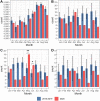Preterm birth, stillbirth and early neonatal mortality during the Danish COVID-19 lockdown
- PMID: 34783897
- PMCID: PMC8593096
- DOI: 10.1007/s00431-021-04297-4
Preterm birth, stillbirth and early neonatal mortality during the Danish COVID-19 lockdown
Abstract
Using provisional or opportunistic data, three nationwide studies (The Netherlands, the USA and Denmark) have identified a reduction in preterm or extremely preterm births during periods of COVID-19 restrictions. However, none of the studies accounted for perinatal deaths. To determine whether the reduction in extremely preterm births, observed in Denmark during the COVID-19 lockdown, could be the result of an increase in perinatal deaths and to assess the impact of extended COVID-19 restrictions, we performed a nationwide Danish register-based prevalence proportion study. We examined all singleton pregnancies delivered in Denmark during the COVID-19 strict lockdown calendar periods (March 12-April 14, 2015-2020, N = 31,164 births) and the extended calendar periods of COVID-19 restrictions (February 27-September 30, 2015-2020, N = 214,862 births). The extremely preterm birth rate was reduced (OR 0.27, 95% CI 0.07 to 0.86) during the strict lockdown period in 2020, while perinatal mortality was not significantly different. During the extended period of restrictions in 2020, the extremely preterm birth rate was marginally reduced, and a significant reduction in the stillbirth rate (OR 0.69, 0.50 to 0.95) was observed. No changes in early neonatal mortality rates were found.Conclusion: Stillbirth and extremely preterm birth rates were reduced in Denmark during the period of COVID-19 restrictions and lockdown, respectively, suggesting that aspects of these containment and control measures confer an element of protection. The present observational study does not allow for causal inference; however, the results support the design of studies to ascertain whether behavioural or social changes for pregnant women may improve pregnancy outcomes. What is Known: • The aetiologies of preterm birth and stillbirth are multifaceted and linked to a wide range of socio-demographic, medical, obstetric, foetal, psychosocial and environmental factors. • The COVID-19 lockdown saw a reduction in extremely preterm births in Denmark and other high-income countries. An urgent question is whether this reduction can be explained by increased perinatal mortality. What is New: • The reduction in extremely preterm births during the Danish COVID-19 lockdown was not a consequence of increased perinatal mortality, which remained unchanged during this period. • The stillbirth rate was reduced throughout the extended period of COVID-19 restrictions.
Keywords: COVID-19; Epidemics; Infant, extremely premature; Infant, premature; Perinatal death; Stillbirth.
© 2021. The Author(s).
Conflict of interest statement
Dr Breindahl has a patent (NeoHelp) with royalties paid. Dr Breindahl has nothing else to disclose. All other authors reported to have nothing to disclose.
Figures



Similar articles
-
Increase in preterm stillbirths in association with reduction in iatrogenic preterm births during COVID-19 lockdown in Australia: a multicenter cohort study.Am J Obstet Gynecol. 2022 Sep;227(3):491.e1-491.e17. doi: 10.1016/j.ajog.2022.04.022. Epub 2022 Apr 19. Am J Obstet Gynecol. 2022. PMID: 35452655 Free PMC article.
-
The impact of COVID-19 first wave national lockdowns on perinatal outcomes: a rapid review and meta-analysis.BMC Pregnancy Childbirth. 2021 Oct 6;21(1):676. doi: 10.1186/s12884-021-04156-y. BMC Pregnancy Childbirth. 2021. PMID: 34615505 Free PMC article. Review.
-
Adverse pregnancy outcomes during the COVID-19 lockdown. A descriptive study.BMC Pregnancy Childbirth. 2021 Nov 10;21(1):761. doi: 10.1186/s12884-021-04221-6. BMC Pregnancy Childbirth. 2021. PMID: 34758778 Free PMC article.
-
Modest reduction in adverse birth outcomes following the COVID-19 lockdown.Am J Obstet Gynecol. 2021 Jun;224(6):615.e1-615.e12. doi: 10.1016/j.ajog.2020.12.1198. Epub 2020 Dec 24. Am J Obstet Gynecol. 2021. PMID: 33347842 Free PMC article.
-
Obstetric and perinatal outcomes of pregnancies with COVID 19: a systematic review and meta-analysis.J Matern Fetal Neonatal Med. 2022 Dec;35(25):9742-9758. doi: 10.1080/14767058.2022.2051008. Epub 2022 Mar 13. J Matern Fetal Neonatal Med. 2022. PMID: 35282784
Cited by
-
Changes in birth outcomes and utilization of prenatal care during the COVID-19 pandemic in 2020: a secondary analysis of vital statistics in Colombia.BMC Pediatr. 2023 May 12;23(1):234. doi: 10.1186/s12887-023-04027-9. BMC Pediatr. 2023. PMID: 37173676 Free PMC article.
-
Social distancing and extremely preterm births in the initial COVID-19 pandemic period.J Perinatol. 2024 Jul;44(7):1050-1057. doi: 10.1038/s41372-024-01898-3. Epub 2024 Feb 22. J Perinatol. 2024. PMID: 38388715 Free PMC article.
-
Preterm birth rates among twins during the Danish COVID-19 lockdown and when restrictions were relaxed.Acta Paediatr. 2023 Feb;112(2):298-300. doi: 10.1111/apa.16583. Epub 2022 Nov 4. Acta Paediatr. 2023. PMID: 36301145 Free PMC article. No abstract available.
-
COVID-19 pandemic and population-level pregnancy and neonatal outcomes in general population: A living systematic review and meta-analysis (Update#2: November 20, 2021).Acta Obstet Gynecol Scand. 2022 Mar;101(3):273-292. doi: 10.1111/aogs.14318. Epub 2022 Jan 27. Acta Obstet Gynecol Scand. 2022. PMID: 35088409 Free PMC article.
-
Time series analysis of impact of COVID-19 on infant and neonatal mortality in the United States.Pediatr Res. 2025 Jun 2. doi: 10.1038/s41390-025-04054-5. Online ahead of print. Pediatr Res. 2025. PMID: 40456916
References
-
- Hedermann G, Hedley PL, Baekvad-Hansen M, Hjalgrim H, Rostgaard K, Poorisrisak P, Breindahl M, Melbye M, Hougaard DM, Christiansen M, Lausten-Thomsen U. Danish premature birth rates during the COVID-19 lockdown. Arch Dis Child Fetal Neonatal Ed. 2021;106:93–95. doi: 10.1136/archdischild-2020-319990. - DOI - PMC - PubMed
Publication types
MeSH terms
LinkOut - more resources
Full Text Sources
Medical
Miscellaneous

